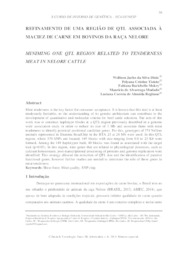Refinamento de uma região de QTL associada à maciez de carne em bovinos da raça Nelore.
Refinamento de uma região de QTL associada à maciez de carne em bovinos da raça Nelore.
Summary: Meat tenderness is the key factor for consumer acceptance. It is known that this trait is at least moderately heritable, so the understanding of its genetic architecture can contribute to the development of quantitative and molecular criteria for beef cattle selection. The aim of this work was to construct haplotype blocks in a QTL region previously described in a genome wide association study in order to reduce its size of 1 Mb and associate them with meat tenderness to identify potential positional candidate genes. For this, genotypes of 374 Nellore animals represented in Illumina BeadChip in the BTA 23 at 24 Mb were used. In this QTL region, where 570 SNPs are located, 149 blocks with size ranging from 0.8 to 23 Kb were formed. Among the 149 haplotypes built, 40 blocks was found as associated with the target trait (p<0.05). In this region, nine genes that are related to physiological processes, such as calcium homeostasis, post-transcriptional processing of proteins and genome replication were identified. This strategy allowed the reduction of QTL size and the identification of putative functional genes, however further studies are needed to determine the role of these genes in meat tenderness.
Publication year: 2014
Types of publication: Journal article
Observation
Some of Embrapa's publications are published as ePub files. To read them, use or download one of the following free software options to your computer or mobile device. Android: Google Play Books; IOS: iBooks; Windows and Linux: Calibre.
Access other publications
Access the Agricultural Research Database (BDPA) to consult Embrapa's full library collection and records.
Visit Embrapa Bookstore to purchase books and other publications sold by Embrapa.

